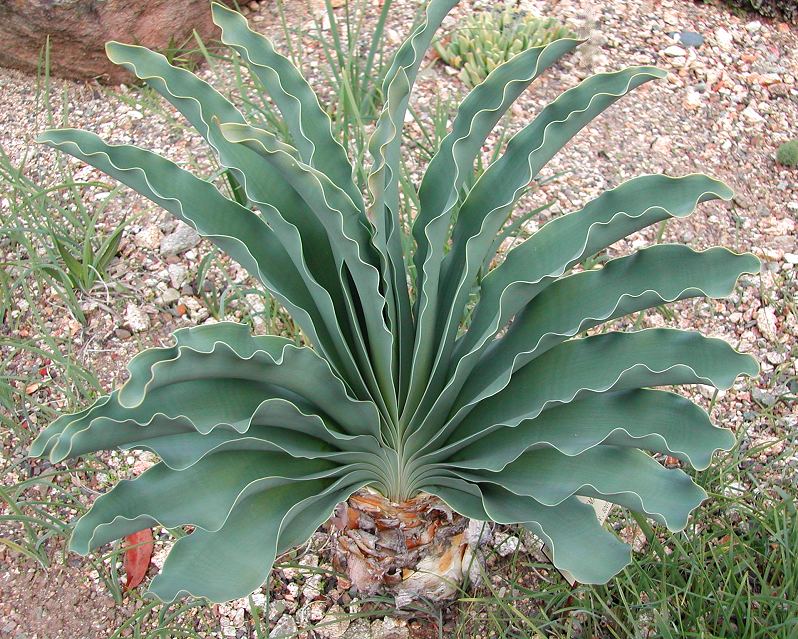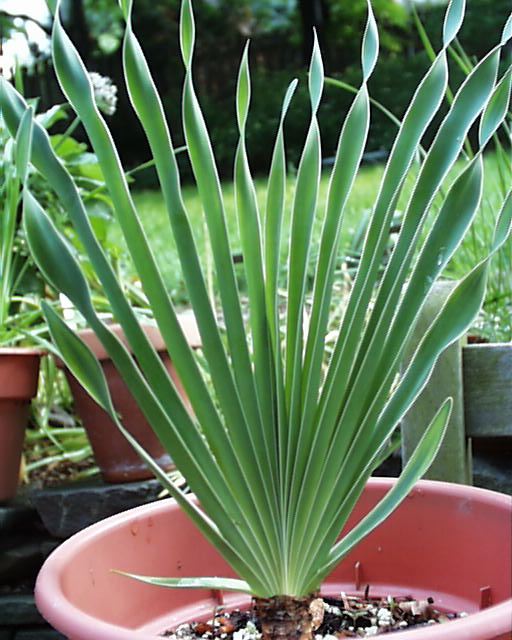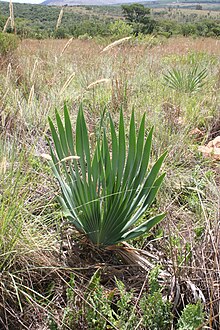Boophone
The genus belongs to the subfamily Boophone Amaryllidoideae within the family of the Amaryllis family ( Amaryllidaceae ). The only two species are native from South Africa to the tropical East Africa.
- 5.1 Notes and references
Description
Appearance and leaves
The Boophone species grow as perennial herbaceous plants reach stature heights of 30 to 50 cm. They form onions as outlasting that protrude more or less from the ground. The bulbs are densely covered with greyish onion shells ( Tunica ). They move around as geophytes in the dry season, their leaves, which sprout again after flowering.
The 12 to 20 only basal and clear double row ( like a fan, hence the less frequently used common name subjects Lily) arranged, more or less erect leaves are sessile. The simple leaf blades are usually narrow lanceolate, smooth and parallel-veined. The translucent leaf margin is smooth or sometimes wavy.
Inflorescence and flowers
The flowering time is in South Africa from September to March. The strong inflorescence stem is initially very short and extended often only when the flowers have already opened and it will be extended even further to fruit maturity. 50 to 100 or more flowers are bunched together in a spherical, doldigen inflorescence. In knospigen state envelop two broad bracts ( spathe ) and has the inflorescence; they are bent back during anthesis erect up and then fade soon. The flower stems are relatively long and longer still significantly to fruit maturity.
The relatively large flowers are hermaphroditic, radial symmetry and threefold. The six identically shaped bracts are fused to a short, narrow tube. The free areas of the bracts are narrowly lanceolate, spreading and often recurved at the upper end. The bloom are light to dark pink or cream-colored. The six more or less outstretched stamens protrude beyond the perianth. The dorsifixen anthers are cream-colored. Three carpels are fused to a dreikammerigen, inferior ovary. Each ovary chamber contains one or two ovules. The thin upright or slightly curved style ends with an undivided scar. The fragrant flowers are pollinated by bees and flies.
Fruit and seeds
The triangular seed capsules are tapered at their base and short beaked. The three edges of the capsule fruits are ribbed sublime. The papery pericarp opens in irregular parts. The relatively large, with a diameter of 8 mm to 11 mm, almost spherical seeds are light green and thin corky covered. The embryo is green. The whole fruit stand acts as a steppe Roller ( Chamaechorie ), thus ensuring the spread of the seeds, but they break up soon.
Chromosome number
The basic chromosome number is x = 11
System
The genus name Boophone in 1821 by William Herbert in An Appendix: General index to the Botanical magazine, vol. 43-48 Containing a treatise on bulbous roots By William Herbert with plates. London, published for the first 18. Only synonyms are the spellings Boophane Herb., Buphane Herb. and Buphone Herb .. The botanical name Boophone is derived from the Greek words Bous for beef, ox and phonos for murder, slaughter, slaughtering, this refers to the toxicity of onions that can kill cattle.
Boophone is the only genus of the subtribe Boophoninae from the tribe Amaryllideae in the subfamily Amaryllidoideae within the family of Amaryllidaceae. Previously, she was also classified in the family Liliaceae. The formerly classified here Boophone types flava WFBarker ex Snijman and Boophone guttata (L.) Herb. in 1994 by Dietrich Müller- Doblies and Ute Müller- Doblies notulae in De Liliifloris: 5 Some new taxa and Combinations in the Amaryllidaceae tribe Amaryllideae from arid southern Africa, In: Feddes Repertorium, vol 105, pp. 331-363 reactivated in the genus Crossyne Salisb. provided.
There are only two types of Boophone:
- Boophone disticha ( L. F. ) Herb. ( Syn: Boophone longepedicellata Pax ): It is widespread from South Africa to Uganda. In KwaZulu -Natal and Gauteng, stocks are greatly reduced by collecting the onions. But it is not at risk.
- Boophone haemanthoides FMLeight ( Syn: Boophone ernestii - ruschii Dinter ex Such, Boophone disticha var ernesti - ruschii Dinter & GMSchulze ): It thrives on dolerite and limestone outcrops in the winter rainfall region of Namaqualand and Western Karoo. It is in the red list of endangered plant species in South Africa as " Least Concern " = " not at risk " rating.
Use
The highly poisonous bulbs of Boophone disticha are very commonly used in many parts of Africa in traditional medicine.
More images
Boophone disticha:
Capsular fruits with seeds.
Seeds.
Swell
- John C. Manning, Peter Goldblatt & Dee Snijman: The Color Encyclopedia of Cape Bulbs, 2002, Timber Press, Portland. ISBN 0-88192-547-0 (Section Description and occurrence): Boophone on page 94-95



%252520Herb.-1335254272.jpg)





